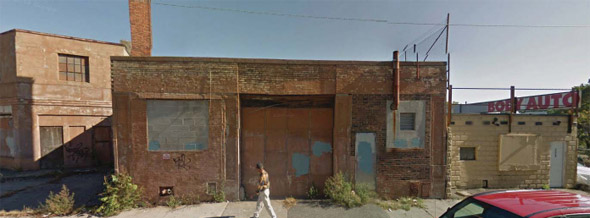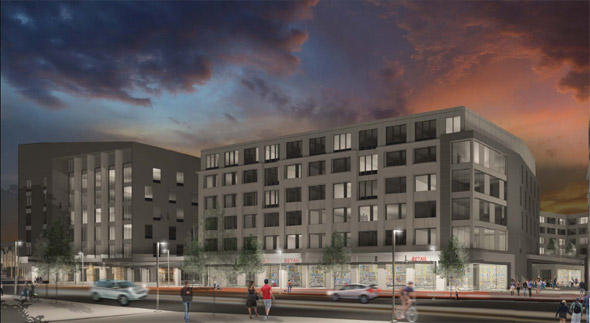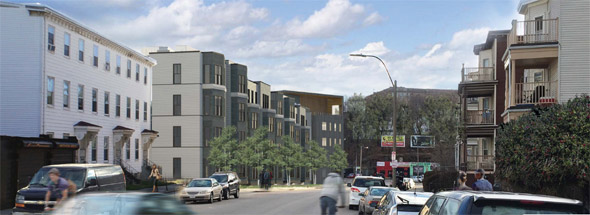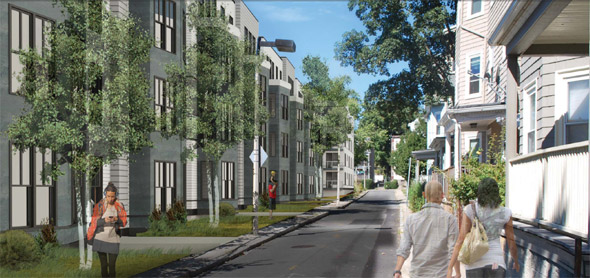Mixed-use development would transform Dorchester block

Architect's rendering: Glover's Corner view.
Architects for developer Demetrios Dasco have released renderings of his proposed DotBlock, which would replace a series of low-slung storefronts and industrial buildings at Dorchester Avenue and Hancock Street with 384 apartments, 60,000 square feet of retail space, a 450-car garage and a large pedestrian walkway parallel to Dot. Ave.
The renderings are in a filing with the BRA (42M PDF file) for what is so far the largest of a growing number of projects proposed for Dorchester.
One of the current buildings, on Hancock::

Proposed new building on Hancock:

Dot. Ave. view:

Looking south:

Pleasant Street:

Greenmount:

Ad:

Comments
And now the gentrification of
And now the gentrification of Dorchester begins.
Begins?
Dorchester has always been a mixed neighborhood (in every way--economically, ethnically) and has had plenty of what you call "gentry" but I'm curious--what would YOU do with a block of boarded up or abandoned buildings? Leave them be? I'm not in love with the look of these new designs but boy, am I tired of the "all development is bad" "building anything=gentrification" drumbeat.
The buildings being replaced
The buildings being replaced are mostly vacant and run down. I'm generally happy to see this development. But I hate the look, at least as shown in these pictures. The architecture reminds me of Soviet or North Korean brutalist architecture. Needs some color.
Agree completely.
This grey on grey with a dash of grey thing does not age well. In a cold climate too it's especially dispiriting in the bleaker months. We need all the warmth we can get.
Actually,
the gentrification of Dorchester started in the late 70s, early 80s. It just wasn't as predominant as say, the South End, or more recently South Boston.
Sigh.
You realize that Dorchester is not and was not ever a swath of unrelieved poverty? Look at the housing stock--it's a wild mix, from massive Queen Anne's to every kind of triple decker and little colonials and ranch houses. It's been predominantly a working class neighborhood but to say that it started "gentrifying" in the 1970s seems like a huge oversimplification.
Sigh back at you Sally
I've lived in Dorchester for my entire life of more than 60 years, so I don't need a snarky lesson on Dorchester's architectural, economic, and (you didn't mention racial) diversity.
My reference to the late 70s and early 80s is relevant. That's when "yuppies" as they called them, young urban professionals, from Back Bay, South End, etc, started to move into Dorchester, usually in specific areas with big Victorian houses, near public transportation, buying usually from life long residents who wanted to move out. Previously stable and affordable real estate values started to rise due to the demand.
So yes, gentrification started in Dorchester in the late 70s or 80s. Prior to that in the 50s and 60s, and early 70s, the people moving into Dorchester were usually working class or immigrants, and gentrification was definitely not happening. Prior to the late 70s, the "gentry" was moving out of Dorchester, and not moving into Dorchester. The dynamic changed dramatically in the late 70s.
What you describe is not gentrification
Dear anon,
I am going to have to agree with Sally here. What you are describing is closer to the "natural" ebb and flow of the real estate market not gentrification. Gentrification usually involves two cycles, the first being a new group of people moving into a neighborhood, i.e. artists in the South End, who displace lower income residents, and the second cycle when wealthier individuals are drawn to a place that is "new" or "cool" but has been made "safer" by the "early adopters'. The second cycle is traditionally when you see rents and values reach even higher heights. Dorchester, outside of people that are OFD, does not have the historical record of early adopters, i.e. artists, LBGT community, that places like the South End, JP, Southie did.
Now, there may have been a period or two of development within Dorchester in the 70s & 80s but most of it seemed to happen in the late 90s, i.e. South Bay, Fields Corner Rehab, and parts of Savin Hill. But by stating that the gentrification was not as prevalent in Dorchester as it was in the South End or South Boston implies that it was not gentrification. I also disagree with your perception of the timeline too. The South End, JP, and South Boston did not start their "revitalization" until the late 80s and into the 90s with the real boom in the early 2000s.
No snark intended
and I take your point, but I still say that calling it "gentrification"--at least the way that people tend to toss that term around these days--is oversimplifying. The people I know who have moved in and out of Dorchester since the 1970s and who live there now are very hard to classify--I wouldn't say that anyone I knew who moved there in the 1970s or 80s was a "yuppie." And as you say, at different points the existing "gentry" started to move out and were replaced by...well, it depends. Some neighborhoods got poorer and more rundown. Some got gussied up. But I'd still say that Dorchester has been kind of a holdout of diversity that's hard to find elsewhere. And it was only 10-15 years or so ago that I was looking at big old rundown Victorians in the low $200s. If "gentrification" really started in the 1970s then it's been kept pretty well under control.
Are you thinking of South Dorchester or North Dorchester?
I can't speak to the real estate trends in South Dorchester, but North Dorchester has not been gentrifying since the 70s, in fact far from it. The 1980s and 1990s were horrible decades for North Dorchester in terms of violent crime, declining property investment, and loss of working class and middle class people (not just families). Things really started to change in the early 2000s. While there have always been small pockets of steady investment (e.g., Savin Hill, Jones Hill, Melville Park) it has only been in recent years that I would say North Dorchester has started to see the return of substantial numbers of middle class people and, in some areas, real "gentrification." I would count this area of Dot Ave around Glover's corner as pretty squarely part of North Dorchester and my sense is that it is starting to see real interest because of the rejuvination of Fields Corner further down Dot Ave and the gentrification that I think has started to now spread out of Savin Hill along Dot Ave from Columbia Road to the Glover's Corner area. Right now, parts of North Dorchester are a total value. The housing stock requires renovation, but it tends to be large and formerly grand. There is public transportation on the red line (and commuter rail now that the Fairmount line stations are done) littered all over the place, and real estate is still priced pretty low (in Boston terms). I think you are about to see what the gentrification of Dorchester will really look like.
You realize that Dorchester
"You realize that Dorchester is not and was not ever a swath of unrelieved poverty?"
Finally, someone gets it. Thank you Sally!!
Just continue housing shortage?
Is that your preferred scenario?
We Must Stop This Project
This project will destroy an abandoned warehouse, a gas station, a few auto repair garages and some really, really overgrown lots. Glover's Corner was considered by many to be seedy in the 80's, the 1880's.
Let's keep it that way cause that will show those yuppies who is boss. Rock on WFT021. Let's keep the revolution at bay and go drinking in the Marsh or at Peggy O'Neil's when we have a chance. We can kill a few Buds and talk about how great our existence is.
This post
is one of the best posts ever on Uhub, and the line about Glovers Corner in the 80s is an instant classic.
It is fun to watch people
It is fun to watch people flip out by stating one simple little fact. People assume I am against gentrification by stating that it has started in Dorchester. Just the opposite, I am all for it. Way to jump to conclusions people.
Maybe you need to brush up
On your communication skills then? It's very rare that anyone uses the term "gentrification" as a positive in today's climate. If you really meant to express your approval of the project, there are better ways.
Peggy O'Neils
Will become a curated artisanal micro-brew pub serving curated artisanal grass fed burgers.
I'd prefer it to be the Glass Top again
Nothing says more fun in my book than a cocaine infested lesbian biker bar.
Wow. I always assumed glass
Wow. I always assumed glass too was a stripper bar.
Sorry, but I think it's already begun
And I'm not sure I see how lots of housing instead of boarded up garages is a bad thing. Have you TRIED being a renter in this city??
Looks more like the
Looks more like the developers prefer to create a space 'attractive' to commuters who fear Dorchester as opposed to locals and nearby residents. Who would want to walk by or frequent shops in this corporate box devoid of human spirit? So much potential down the drain. What school is churning out these 'Walmart' cheapo archiects?
Gentrification
The boat has sailed about 10 years ago - some areas, Savin Hill OTB in particular, are already fetching JP-level prices.
Gentrification
Made me $150,000 so far, in echange for losing that warm fuzzy social justicey feeling of knowing the poorest of the poor can afford to live in my neighborhood. Now, I'm sure that feeling might be worth more than $150,000 to someone with a nice chunky trust fund or upcoming multi-million dollar inheritance, but it's not worth much to me.
Parking ratio
EDIT: The ratio is not 1.17. It is 0.78, as 120 spots are for retail and the number of units has been increased to 420. This is the ideal sweet spot for proper urban design. See thread below for clarifications.
I'm glad the parking garage is totally hidden within the interior courtyard, at least.
Otherwise, it looks like a fantastic project. The massing is all excellent and fits within the context beautifully.
Just great dense & urban figure-ground massing:

That number of parking spaces
That number of parking spaces jumped out as ridiculous to me as well. Housing costs are a huge issue in Boston and forcing people who don't have cars to pay for a parking spot is only making matters worse.
Agreed completely and yet...
It's not a hard commute into town but Dorchester is still a bit more car-oriented and less dense than other boston neighborhoods. More spread out, fewer supermarkets and services in concentrated areas--it's just a bit tricky to manage without a car. One of the reasons I decided not to move there years back. I feel like developers are between a rock and a hard place on this issue--if they have parking spots they raise their costs and get accused of catering to car culture; if they don't, residents scream that the new arrivals will take all their parking spots!
solution?
Design it in such a way that that big lot (structure? I haven't looked at the full filing yet) in the middle is easily converted to more housing, with the driveway being a road that goes through it, breaking up the superblock.
Before You Go Overbaord On The Parking
Not everyone lives alone and is a creative consultant at some start up on Third Street and can be at Kendall in 20 minutes from Savin Hill. Not everyone has a roommate and works at a software company on Melcher Street and bikes it in. Not everyone is 27 and can walk the two miles to Star Market and then back with arms full of groceries. Not everyone doesn't have a kid that needs to get from their hockey game at Neponset while the other parent speeds the younger sister to the soccer game at PJPII Park. Some people just need a car more than you. That's nuts isn't it?
Everyone
So because some households will own cars, there needs to be more than one spot per household? Just in case? Increasing the rental cost for everyone in the complex, whether or not they have a car? There are parts of the city where zero one site parking makes sense, but this isn't one of them, and no one is arguing for that, except your strawman.
Thank you. I'd like to see a
Thank you. I'd like to see a 0.8 or similar ratio here, not a net zero like Lovejoy Wharf.
Where do you live?
Do you actually actually live there and use dot ave to commute to work every day? Or are you one of those suburbanites who would love to see fewer cars in the city so there's more open parking spaces for your land barges whenever you're in town to see a game?
What the f? Chelsea and
What the f? Chelsea and formerly Brigham Circle, so yes, I very much live in the urban core and have done so for quite a few years. I don't have a car and use the T to get everywhere, but my husband does as he needs to drive to work in the burbs. I also don't give a f- about the Sox, nor would I ever be stupid enough to drive into the city for such an event. I drive to Gillette to see Revs games. That's pretty much the only time I ever drive the car.
?
Roxbury, I used to work on Dot Ave. I biked over (btw, does anyone know of plans to fix the Melnea Cass cycletrack? Last I was on it it was almost unridable). Where Dot Ave has bike lanes (from this parcel north, basically) it was usually very smooth and simple going, and felt as safe as on-street bike lanes get.
Presumably, Some Of The Parking Is For The Retail Space
"22 space covered lot
"22 space covered lot dedicated to retail parking."
tough area
Hard to get around this part of town without a car. Easy enough to get downtown or to Kendall... hard to get anywhere else. Traffic is miserable on dot ave on this stretch most days.
Love everything about this project. Real urban streetscapes, ground floor retail, mix of rental and condo. We need dozens of these projects springing up on these types of underutilized corners throughout the city. This is a great model to follow and hopefully other developers are taking notice.
miserable
If traffic is miserable it sounds hard to get around even with a car.
Car Share?
It seems like a good place for a bunch of car share spots. Not sure how many are in that area but I could see them being used by lot of people in this complex and the surrounding neighborhoods.
Speaking of Neponset, was
Speaking of Neponset, was that ever considered for a Red Line stop?
There was a Pope's Hill stop
There was a Pope's Hill stop years ago. No plan now.
To your edit
I saw 22 spaces being for retail, in a separate covered lot. Where did you see 120?
Parkng
Please, please, please do not make the same critical mistake that occurred in Southie.....more housing not enough parking.
On the positive side, maybe some of the yuppies will overlook Southie and start buying in Dorchester.
Parking Gargae
Do we know what the breakdown is on the use of the spaces? I'm assuming there is some kind of a mix between the residents and the commercial space. Also, what if one of the tenants is a grocery store - makes this whole thing much more appealing and manageable, right?
the pedestrian connection is
the pedestrian connection is perpendicular not parallel.
As for parking, the ratio is not 1.17 per unit.
1.0 per condo and .75 per apt. The rest is for the retail.
You geniuses can argue whether those are appropriate or not, but lets at least have the facts correct for a change.
You are correct. I read
You are correct. I read through the PNF and found the part where it describes parking:
The number of units has also increased to 420, so 330/420 gives a ratio of 0.78.
http://www.dotnews.com/2015/dot-block-plans-grow-new-dot-ave-parcel-acqu...
Girls calm down
Ive been to two community meetings about the project. The parking spots for the apartments are for rent independent of the unit. They won't influence the cost if you don't have a car. And as someone who lives .2 miles away, im pretty much in a octopus dress screaming "KEEEPPPPP BUILDDDDINNNGGGG!!!"
calm down boy! and why are
calm down boy! and why are calling adamg a girl?
Actually L'ing OL
I sooooo want to see this octopus dress!
I want an octopus dress!
And I'm a guy! (Though I have been known to wear skirts...)
(No subject)
The most important issue here is...
will the construction be done by local unions - Iron workers Loc 7 IBEW Loc 103 and the Boston carpenters union?
This thread is perfect
Why is housing so expensive?
1) People don't want construction in general
2) people with various agendas want to dictate the kind of construction instead of letting the market decide (i.e. parking spaces and unit size)
3) people want to ensure the right people are getting the jobs doing the construction (south shore labor unions who largely don't live in Boston).
mixed-use but will it be mixed-income?
but is it mix-income? I glanced at the PDF and searched for low-income, affordable units, and didn't see mention of it. I wonder if a percentage of the units will be designated for lower-income Dorchester/Boston residents.
Finally! Dot ave needs more
Finally! Dot ave needs more big idea developments like this ! Love how building is right to the sidewalk (as opposed to a parking lot at the sidewalk). Dot is Boston's largest neighborhood in area and in population...let's have more developments like this that take advantage of nearby transit - busses, trains and access to major highways. Good luck to the developers in getting this done. Hopefully more will do same because dorchester is a great neighborhood has more community meetings than you can swim a cat at and has a ton of development potential....bring it on! Yeah!
Apts or Condos?
Hope some of these will be condos...I'm ok with a mix, but ownership brings stability.
Both
I don't feel like searching the filing for the numbers, but yes, it will be a mix. The ratios on these things tend to change anyway as the developers look at the market closer to completion.
Characterless Development is Better Than Vacant Lots and Blight?
I agree that they grey on grey color scheme might be bleak, it will be better than the weedy lots and graffiti-spattered semi-abandoned industrial spaces. Currently, this is one of the worst looking blocks in the entire city. As a Dot homeowner, I hope that they do SOMETHING with that block. If I were a renter, I'd be on the fence: more housing could drive rents down OR development will likely make the area more desirable which could drive up rents.
They forgot the blimp
Silly architects.
Possible Retail options?
Dot Block developers...please recruit a Trader Joes (like the one in Brookline that sells beer) for your location...a Quodoba or chipotle would be great too...